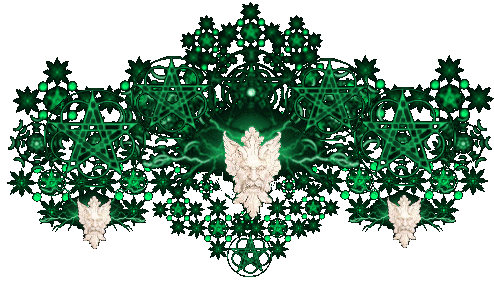


This page was created to blast away all the sterotypes about Witches and Pagans. We are not evil. We don't harm or seduce people. We are not dangerous. We are ordinary people like you. We have families, jobs, hopes, and dreams. We are not a cult. This religion is not a joke. We are not what you think we are from looking at T.V. We are real. We laugh, we cry. We are serious. We have a sense of humor. You don't have to be afraid of us. We don't want to convert you. And please don't try to convert us. Just give us the same right we give you--to live in peace. We are much more similar to you than you think.
-Margot Adler-

And give reverence to the Great God
I am a Pagan
A stone in the ancient circle
Standing firmly
Balanced on the earth
Yet open to the winds of heaven
And enduring through time
May the old gods witness my words
Blessed be.

When one defines oneself as Pagan, it means she or he follows an earth or nature religion, one that sees the divine manifest in all creation. The cycles of nature are our holy days, the earth is our temple, its plants and creatures our partners and teachers. We worship a deity that is both male and female, a mother Goddess and father God, who together created all that is, was, or will be. We respect life, cherish the free will of sentient beings, and accept the sacredness of all creation.
~Edain McCoy~

The Goddess and God are revered. This is central to Wiccan thought. Human souls enjoy a series of incarnations. Reincarnation is one of the most wide-spread of Wiccan beliefs. Precisely how and why we incarnate several times is open to mystical speculation. Power can be sent in non-physical form to affect the world in positive ways. Thus, we accept both the practice of magick and its effectiveness. What is done will be returned to the doer. Precisely how this energy is returned has been a matter of great speculation. The Earth is our home, our Goddess. It's not a tool that we can ruthlessly abuse. Ecological concerns are rather new in Wicca, but now pay an important role. Many rituals are performed to give healing strength to the Earth. Wiccans aren't evangelical. We have no need to go out and spread the word. Answering questions about our religion is far different from knocking on doors and asking strangers, "Have you heard the word of the Goddess today?" Wicca accepts that every religion is correct to its adherents. This doesn't mean that we like every representative of every religion, but ecumenicism must be the way of life. Wicca accepts members from both sexes, from every race, national origin and, usually, of every sexual preference. Wicca is a religion, not a political organization. Groups of Wiccan can and sometimes do work toward a common case, and individual Wiccans may indeed become personally involved in the political system, but Wicca as a whole isn't a religion that preaches issues or supports specific political candidates. Wicca Doesn't charge for private lessons or for initiation. Physical objects created by Wiccans (pentacles, knives, wands, incenses, oils, books) and services (such as public classes and Wiccan-based counseling) can and should be paid for, but not personal, private Wiccan instruction or initiation. Wiccans Do not sacrifices animals or people in rituals! Wiccans do not cause harm to others. Unless in self defense. "Harm None"
This information taken from "Living Wicca" by Scott Cunningham.

By celebrating the natural cycle of the year through ritual, we can attune ourselves to nature and the Universe.
Samhain: October 31
Samhain, popularly known as Halloween, is the Witches' New Year. It is said to be the time when the veil between the worlds is very thin, when souls that are leaving this physical plane can pass out and souls that are reincarnating can pass in. Darkness increases and the Goddess reigns as the Crone, part of the three-in-one that also includes the Maiden and Mother. The God, the Dark Lord, passes into the underworld to become the seed of his own rebirth (which will occur again at Yule). Many Pagans prepare a Feast for the Dead on Samhain night, where they leave offerings of food and drink for the spirits. Divination is heightened this night.
Yule: the Winter Solstice Approx. Dec. 21
Candlemas: February 2
Beltane: April 30

